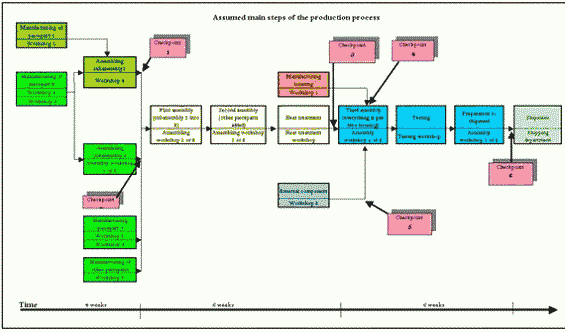The proposed concept of order tracking
Category: Information Systems
- a. The product manufactured consists of four typical components, i.e. subassembly 1, subassembly 2, housing (3), and of an external component (4) which is attached to the completed product.
- b. The manufacturing process consists of six activities
- activity 1, manufacturing of subassembly 1 (light green),
- activity 2, manufacturing of subassembly 2 (green ),
- assembling of the two plus heat treatment (light pink),
- housing manufacturing (orange),
- external component (light blue)
- putting heat treated subassemblies into the housing, adding external component, and testing (turquoise).
- c. The six manufacturing processes on the shop floor are physically represented by six physically identifiable completion stages i.e. the completion of the four components above (subassembly 1, subassembly 2, housing, external component), plus the completion of assembly 1 (subassembly 1 and 2 and assembled and heat treated), and assembly 2 (the aforementioned assembly 1 put into the housing with the external component added, and the whole product tested).
Because those production steps are common for all orders, check points can be attached to the completion of those steps (see red boxes in the flow chart).
An order is reported to have passed
- checkpoint 1, when subassembly 1 is completed and delivered
- checkpoint 2, when subassembly 2 is completed and delivered,
- checkpoint 3, when the housing is completed and delivered,
- checkpoint 4, when assembly 1 after heat treatment is delivered,
- checkpoint 5, when the external component is finished and delivered,
- checkpoint 6, when the finished and tested final product is being delivered.
The completion of «check points» is reported by calendar week. That is, by the end of each week, information is input into the system for each order as to which order stages have been completed.
At the starting date of each manufacturing order, planned completion dates for each stage are fed into the system. Orders stay in the system until they are completely delivered.
The comparison of the actual completion dates, input into the system each week, with the planned completion dates, permits generation of reporting on order progress throughout the order lifetime.
Reporting of order progress just in terms of timeliness — i.e. has planning been met , or by how many weeks has it been missed — is not sufficient for assessing the efficiency of production planning and production. Delays which happen in relation to low value orders do not have the same impact on the company’s performance as if they happen in relation to high value orders. Therefore, a weighting mechanism has been introduced into the system.
The proposed system uses for this purpose the direct material cost which are associated with each of the six processes. It is assumed that the direct material is issued to the next process when the previous process has been completed- independent from the fact whether the next step can start, or not. The rule is that the next production process is charged with the direct material content of the previous process if the work of the previous process has been completed.
The direct material costs are available for each order from the quotation. These calculated direct material costs have to be split in accordance with the six completion stages related to the processes. These calculated direct material costs serve in the system for valuing the movements.

